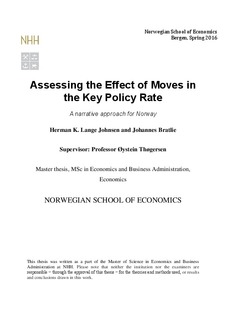Assessing the effect of moves in the key policy rate : a narrative approach for Norway
Abstract
This thesis estimates the effect of the key policy rate on inflation and output for the Norwegian
economy. It applies the narrative identification strategy, pioneered by Romer and Romer, to
identify monetary policy shocks and construct a new measure of monetary policy for Norway.
To our knowledge, this approach has never before been applied on Norwegian data. The new
measure of monetary policy is derived through the construction of a new, real-time forecast
data set, in order to purge the key policy rate of anticipatory movements. It is shown that
estimating a Taylor rule captures a substantial part of Norges Bank’s real-time information set.
To assess the impact of monetary policy in Norway, the new measure of monetary policy is
employed in a vector autoregression. Following a one percentage point shock to the new
measure of monetary policy, the thesis finds that inflation decreases by up to 1.75 percentage
points after five quarters, and that output is reduced by up to 2.71 percentage points after seven
quarters. These estimated effects are significantly larger than the results previously obtained on
Norwegian data. Since the previous studies employ the actual key policy rate as the policy
instrument, this might imply that the new measure of monetary policy, derived in this thesis, is
relatively free of anticipatory movements. The new measure could therefore yield more precise
estimates of the key policy rate’s effect on economic variables. The inclusion of real-time
forecasts, in the construction of the new measure of monetary policy, is shown to be essential
for obtaining the baseline effects. Thisthesis demonstrates that the baseline results are relatively
robust to a wide range of different specifications of the baseline vector autoregression.
